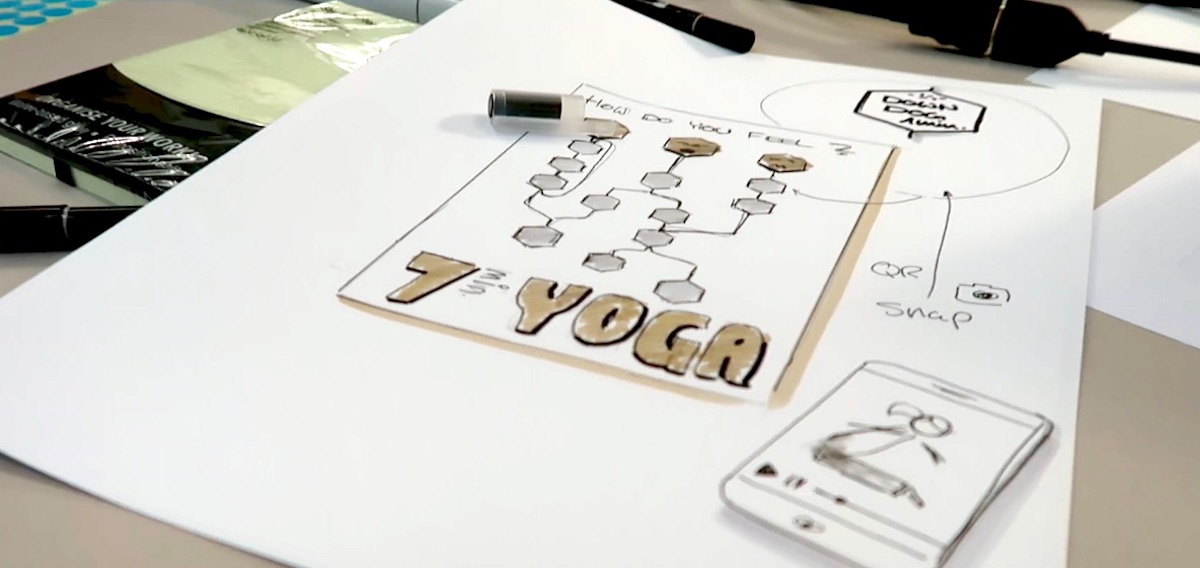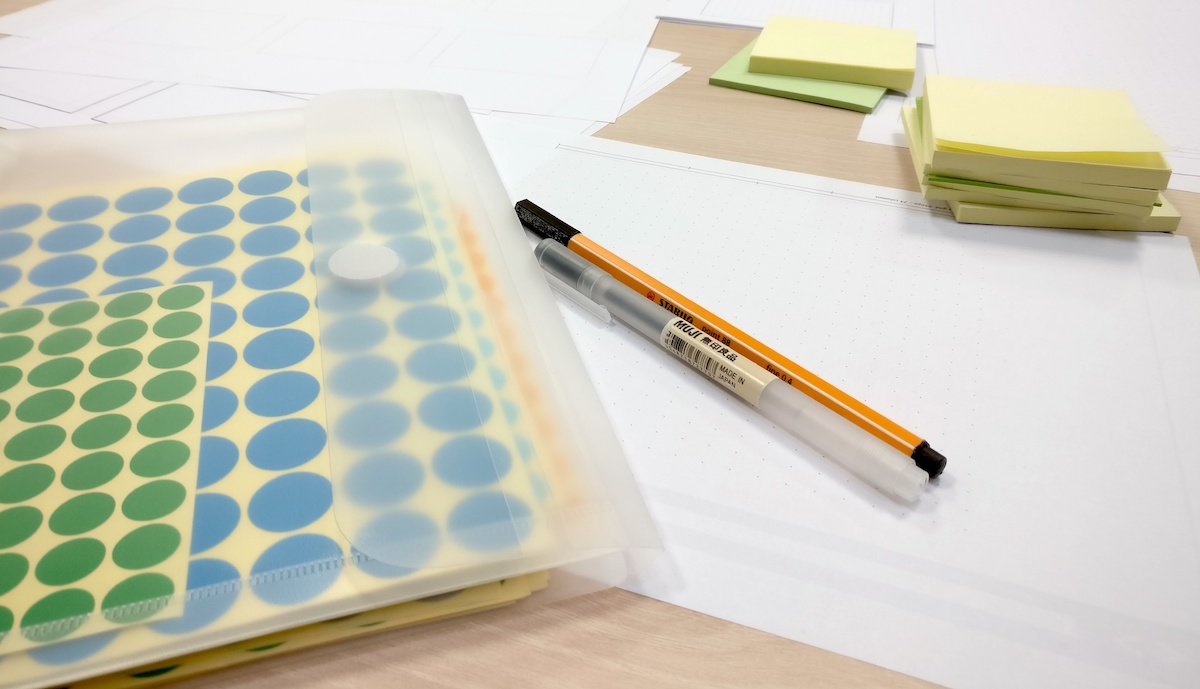Design Sprint 101

Product Design can be a challenging process: How to know what product to work on, which features to prioritize and how to generate innovation? Too often, we find ourselves executing other’s ideas instead of our own, everything takes too long and the outcome is in best case mediocre. It doesn’t have to be like that.
The Design Sprint is a four-day product development workshop originally developed at Google Ventures, using methods from Design Thinking and UX culture. During this five phase workshop, a collection of facilitated and time-constrained exercises helps to address strategic issues using interdisciplinary, rapid prototyping, and user testing. The name “Sprint” refers to the idea of short, fast development cycles in Agile development.
A Design Sprint can shortcut your process, helping you to go from idea to learning directly. It minimises the risk when bringing a new product, feature or service to the market. It’s like taking a look into the future of your company
The Basics of Design Sprints
The Design Sprint has been developed by the design team at Google Ventures as a five-day workshop. The process has been tested, iterated and refined over the years – Google Ventures design partner Jake Knapp claimed that he had run hundreds of Design Sprint workshops. In 2016, he published his findings in the book “Sprint”, together with John Zeratsky and Braden Kowitz. The book is a great way to get into the basics of the Design Sprint process.

Design Sprints combine elements from Design Thinking, rapid prototyping and fast decision making in a group workshop format. The original five-day format has since been updated into a four-day format, named the “Design Sprint 2.0”, which I will cover in this article.
Today, companies like Lego, Slack, Uber, and NASA are using Design Sprints in their everyday design process.
How does the Design Sprint Work?
The Design Sprint 2.0 is a workshop run over the course of four days. It is usually done by a small team of 4-7 designers, marketers or developers. The Design Sprint runs separate from the everyday business, usually in a dedicated room.

Monday is for mapping the design challenge and sketching out ideas for solving it. On that day, the team will dive into the audience, trying to understand and empathize with them. Design Thinking techniques like Personas, Empathy Maps and Problem Reframing (“How Might We …”) help to get to the core of the problem. Ideation techniques like 6-3-5 brain writing or the “Crazy 8” help the team to generate dozens of potential ideas, focussing on output rather than quality.
Tuesday is creating storyboards and deciding on which idea to follow up on. The team will discuss and vote on the ideas created on Monday. After a decision is made, the ideas will be fleshed out in storyboards, trying to create a narrative around the idea, preparing them for the prototyping phase.
Wednesday is for prototyping the idea. Depending on what the outcome will be, the prototype can be either physical or digital. Apps can be built into tappable wireframe prototypes, physical products into cardboard models and services into role play scripts. The flexibility of the Design Sprint model allows for a different outcome, independent from the initial idea.
Thursday is for testing and presenting the prototype. User tests show the viability of each new development and can either verify or smash an idea. Not everything that is produced in a Design is gold – however, finding out within four days rather than four weeks or four months makes the learning much faster and efficient. The successful ideas will be presented to the stakeholders and can be taken to the next stage of development.

Design Sprint Success Stories
In the past years, I have run dozens of Design Sprints with different clients and teams. Here are a few examples of how I used Design Sprints:
A company that is building precision instruments asked me to help them with the controller software for their newest device. They have been developing the new UI for a while and found themselves lost in development cycles: Too slow progress, too little change. It became clear that they weren’t able to deliver their software until the trade show were they wanted to present it. I ran a Design Sprint with the design and development team. In the Design Sprint, they identified the biggest pain points and developed, prototyped and tested several variations of features they needed for their software – a process that would have usually taken them 4-8 weeks, shortened down to just a few days.

Together with the German Space Agency (DLR) and a group of Web Development students, we developed a UX concept for autonomous public transport. We prototyped a self-driving minibus that allowed us to role-play several usage scenarios and identify pain points of all possible passengers. Based on that outcome, we created an app prototype that With the DLR and a group of students, we developed the future app of autonomous public transport. We prototyped a self-driving minibus, run several scenarios and developed an app that would do justice to all the scenarios.

We have been running our food brand «Graphical Cooking» for a few years now – time to think about a future product strategy. Using a Design Sprint, we rapidly prototyped a lineup of potential future products and took “a look into the future” of our brand.
Advantages of the Design Sprint
Serious Time Saver: Product development can take forever. In just 4 days, you take a look in the future of the product and do work that would usually take you 4 weeks or more. In other words: Design Sprints can save you time and money.
Market, User, and Business: In the process, we take a look from different sides at the product and help your team to get a good understanding of all three angles, resulting in better strategic decisions.
Every voice gets heard: Your team is unique and precious. Everyone has certain skills and knowledge, but not everyone might get heard all the time. In the workshop format, we bring all opinions to the table and get really good ideas from the more introvert members of your team.
Align your team: The Design Sprint helps everyone in your team to understand the challenge and vision. By getting your team involved in the decision-making, you give a sense of ownership.
Re-energize your team: The Design Sprint workshop is like a retreat, educates and helps to get new impulses – eventually getting people excited about the product.
A clear roadmap: You leave the Design Sprint with a viable action plan: What do you want, where do you go next?
What do I need for a Design Sprint?
A good problem: Define the challenge you want to work on beforehand. What do you want to work on? What is your goal? A good challenge is something big and meaningful. Too small is bad, too vague is bad.
A hungry team: Assemble a team of 4-7 people from product, marketing, design, and development. Make sure you have a decision-maker in there for at least two days. Additionally, you should have a very experienced facilitator in your team.
Room for creativity: Have a room that you can use for the four days of the workshop that has enough space, empty walls and at least one big table. Having a big TV screen is a plus!
Get sticky notes, sharpies, voting dots, masking tape and lots of white paper for ideas. You can get everything on Amazon – or get the Design Sprint Kit.

Prototyping materials: Play-dough, Lego Bricks, and Cardboard for physical products, Marvel and Wireframes for App ideas. Get creative with materials – what you get really depends on what you plan to create.
Templates: There’s a bunch of really good templates over at Google Ventures, as well as in the Sprint book by Jake Knapp.
A Time Timer: Most Design Sprint exercises are time-boxed, so having a good and visible timer helps. If you don’t have one, a kitchen clock will do the job just fine. Personally, I like to use the Visual Timer on a big Android Tablet.
Healthy Snacks: Don’t forget to feed your hungry team. Provide plenty of water, fruits, and Skittles.
How to get started with Design Sprints
Getting started with Design Sprints is easier than you might think:
- Buy the Sprint Book – and learn about the whole process in detail.
- Define a challenge – what is it that you want to work on?
- Speak to me – I am an experienced Design Sprint facilitator and can help you run your very first Design Sprint